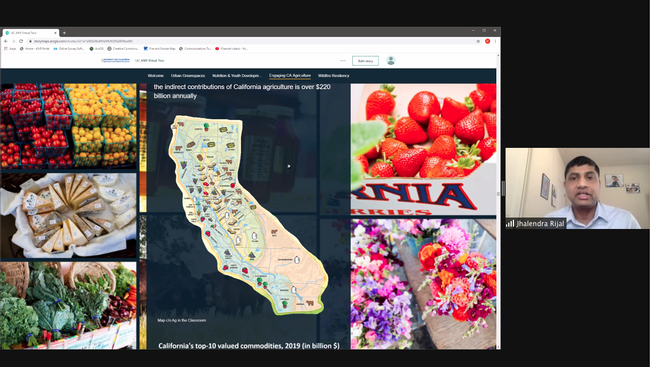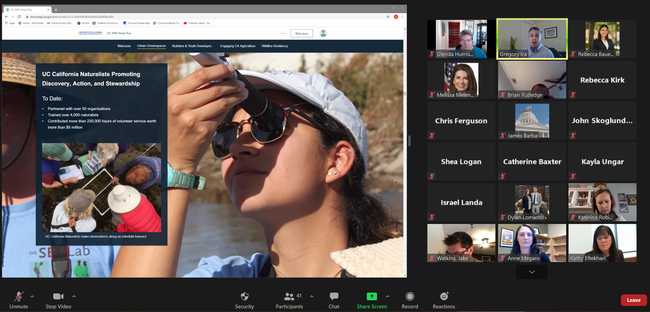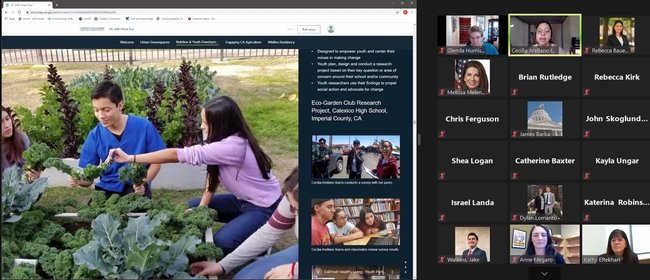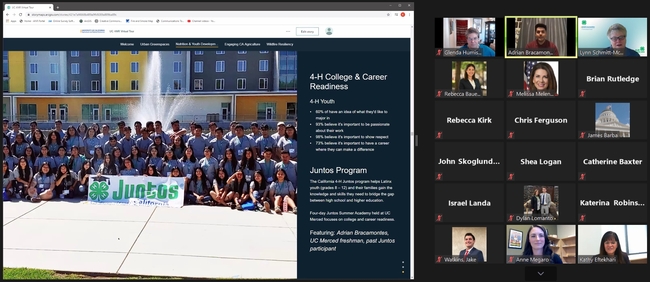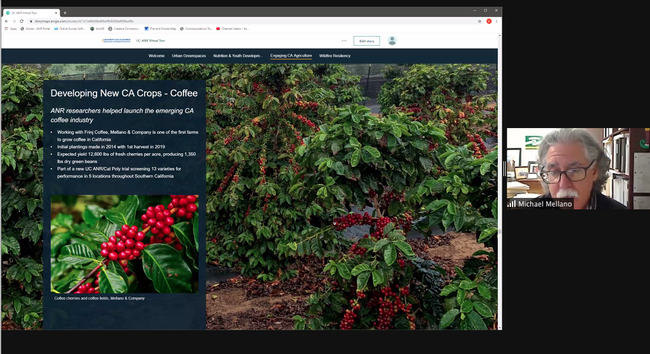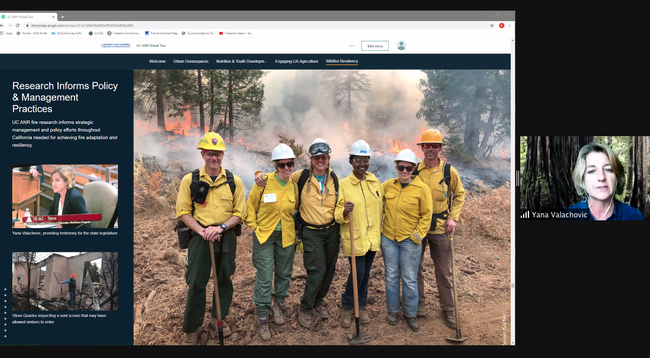Legislators take virtual tour of UC ANR
VP Glenda Humiston led California state legislators, their staff members and other policymakers on a virtual tour of UC ANR on Nov. 20.
Humiston welcomed Assemblymember Rebecca Bauer-Kahan, Assemblymember Robert Rivas, Senator Melissa Melendez and staff of Senator/Pro Tem Toni Atkins, Senators Nancy Skinner and Henry Stern; staff of Assemblymembers Heath Flora and Monique Limon and members of the governor's office and administration.
The tour opened with the We are UC ANR video and a map of UC ANR locations for background. Using short videos and photos, statewide program directors and UC ANR stakeholders showed the policymakers many of the ways UC ANR serves Californians. Other “tour stops” included highlights of UC ANR's impact on urban greenspaces, nutrition and youth development, California agriculture and wildfire resiliency.
Missy Gable, director of the UC Master Gardener Program, kicked off the urban greenspaces presentations by describing the contributions of volunteers. She discussed how the Master Gardener Program has changed during the COVID-19 constraints, noting a surge in the public's interest in gardening and the creation of a virtual classroom for the public in Senator Stern's district.
Jim Farrar, director of the Integrated Pest Management Program, explained that IPM helps all Californians control pests, both agricultural and urban pests. He described the work being done to manage red imported fire ant, bed bugs and invasive shot hole borers.
Greg Ira, director of the California Naturalist Program, said Cal Nat has expanded UC ANR's audience to include a younger, more diverse population in metropolitan areas. He explained how Cal Nat partners with organizations that deliver the course, which opens participants' eyes to the environment and stewardship as paths to green jobs.
Lorene Ritchie, director of the Nutrition Policy Institute, kicked off the nutrition and youth development section of the tour by describing how NPI research has informed policies such as removing chips and soda from schools, the healthy beverages law requiring water be made available to children in all licensed child day-care facilities in California, and the U.S. dietary guidelines.
Kamal Khaira, director of CalFresh Healthy Living, UC, talked about how CalFresh and EFNEP nutrition educators teach people in English and Spanish how to shop for and prepare healthful foods on a limited budget to prevent chronic diseases.
Cecilia Arellano Ibarra, now a UC Davis student, enthusiastically described how she interviewed fellow Calexico High School students to find out why they bought junk food instead of the food served by the school as part of her eco-garden club research project. Based on the student responses, she worked with CalFresh Healthy Living, UC to start a school garden and advocate for a farm-to-school program to provide fresh produce.
Lynn Schmitt-McQuitty, director of the 4-H Youth Development Program, described the 4-H Juntos program, which bridges the gap between high school and higher education with a four-day college and career readiness workshop. UC Merced student Adrian Bracamontes said attending Juntos helped him get scholarships and helped his parents understand the process.
Jhalendra Rijal, area IPM advisor, launched the California agriculture section of the tour by giving guests an overview of the size and scope of California's agricultural commodities. He then talked about the value of the state's nut crops and summarized UC ANR's research to manage navel orangeworm, which attacks almond, walnut and pistachio crops.
Ashraf El-Kereamy, UCCE specialist and director of Lindcove Research and Extension Center, described the citrus breeding and pest management research being done at the REC. For example, the popular Tango mandarin was developed at Lindcove REC with UC Riverside breeders. He also discussed research on Asian citrus psyllid and huanglongbing disease.
Ruth Dahlquist-Willard, small farms advisor, described how UC ANR promotes economic success by developing new crops. Hmong farmers in Fresno County growing the “superfood” moringa consult Dahlquist-Willard about production and regulations while farm advisor Konrad Mathesius is studying malting barley for new flavors of craft beer.
Mike Mellano, third-generation flower grower in San Diego County, UC President's Advisory Commission member and California representative for the Council for Agricultural Research, Extension, and Teaching, told the legislators that his business may not exist as it is today without UC ANR's research to help him compete in the world economy. He has diversified his operations to include agritourism with the Flower Fields at Carlsbad Ranch and growing coffee.
Betsy Karle, dairy advisor, described her work with the state's number one commodity to meet climate goals for methane emissions. She also discussed UC ANR's partnership with the California Department of Food and Agriculture to educate farmers about adapting to climate change.
Yana Valachovic, forestry advisor and UCCE director in Humboldt and Del Norte counties, explained how elected officials can look to UC research to inform policy on issues such as wildfire.
Stephanie Larson, livestock and range advisor and UCCE director in Sonoma County, highlighted UC Cooperative Extension's ability to pivot quickly to address emerging issues of clientele. For example, when Sonoma County residents called asking if food in their gardens was safe to eat after a wildfire, UCCE harvested food from gardens and tested it. UC Davis School of Veterinary Medicine tested eggs from backyard chickens for postfire food safety. They found the eggs and produce were generally safe to eat.
The tour was accompanied by a “learning box” with 11 different items related to the various tour stops for participants to taste, feel and explore. To conclude the virtual tour, Humiston told the legislators, “This is only a fraction of what UC ANR does. We've got hundreds of researchers. When you need information, reach out to us.”
Two similar virtual tours for UC regents and President Drake will be held on Dec. 2 and Dec. 8, respectively. A self-guided version of the virtual tour will be posted online following the last live tour.

